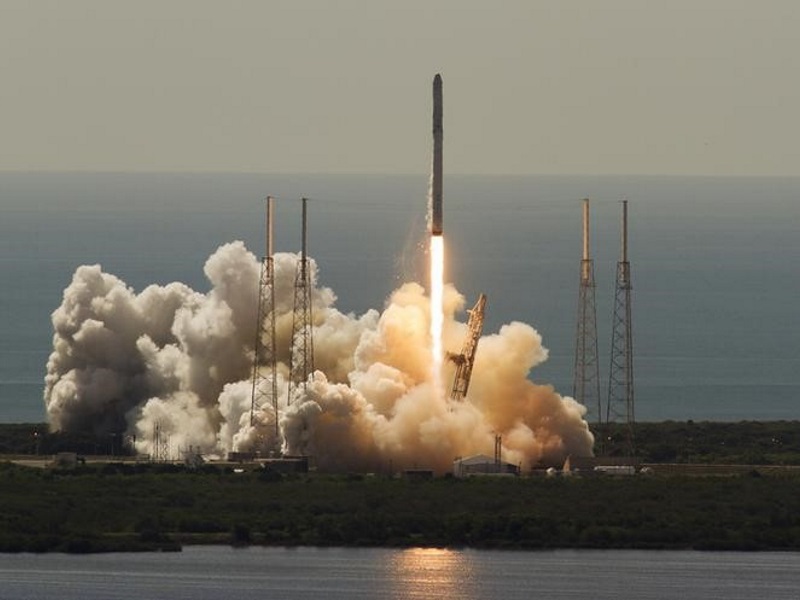- Home
- Science
- Science News
- Repaired SpaceX Rocket to Fly by Early December, Company Says
Repaired SpaceX Rocket to Fly by Early December, Company Says

The 208-foot-tall (63-meter) rocket carrying cargo for the International Space Station exploded less than three minutes after liftoff from Florida on June 28.
The cause of the accident was traced to a faulty bracket inside the rocket's upper-stage engine. When the steel bracket broke, a bottle of high-pressure helium was released, causing the engine to over-pressurise and explode.
"We believe in the next six to eight weeks we'll be able to return to flight," Lee Rosen, SpaceX vice president of mission and launch operations, said on Tuesday at the International Astronautical Congress under way this week in Jerusalem.
The Falcon 9, which failed after 18 successful flights, will carry a communications satellite for Luxembourg-based SES SA.
Privately owned SpaceX is also expected to attempt to land the rocket's first-stage on a platform in the ocean after the second-stage takes over to deliver the SES satellite into orbit.
To try to achieve that, California-based SpaceX will use a more powerful version of the Falcon 9 than it has flown previously. SpaceX wants to return its rockets so they can be refurbished and reflown, slashing launch costs.
"Things are coming along nicely with the upgraded version of the vehicle and we're prepared to get back at this," Rosen said.
SpaceX intends to submit its first bid for a US military launch contract before it returns to flight.
It is expected to compete to fly a next-generation US Global Positioning System satellite. If it wins, the company will break a monopoly on the military's launch business held by United Launch Alliance, a partnership of Lockheed-Martin and Boeing.
Bids for the GPS 3 launch are due on November 16.
© Thomson Reuters 2015
For the latest tech news and reviews, follow Gadgets 360 on X, Facebook, WhatsApp, Threads and Google News. For the latest videos on gadgets and tech, subscribe to our YouTube channel. If you want to know everything about top influencers, follow our in-house Who'sThat360 on Instagram and YouTube.
Related Stories
- Samsung Galaxy Unpacked 2025
- ChatGPT
- Redmi Note 14 Pro+
- iPhone 16
- Apple Vision Pro
- Oneplus 12
- OnePlus Nord CE 3 Lite 5G
- iPhone 13
- Xiaomi 14 Pro
- Oppo Find N3
- Tecno Spark Go (2023)
- Realme V30
- Best Phones Under 25000
- Samsung Galaxy S24 Series
- Cryptocurrency
- iQoo 12
- Samsung Galaxy S24 Ultra
- Giottus
- Samsung Galaxy Z Flip 5
- Apple 'Scary Fast'
- Housefull 5
- GoPro Hero 12 Black Review
- Invincible Season 2
- JioGlass
- HD Ready TV
- Laptop Under 50000
- Smartwatch Under 10000
- Latest Mobile Phones
- Compare Phones
- Moto G15 Power
- Moto G15
- Realme 14x 5G
- Poco M7 Pro 5G
- Poco C75 5G
- Vivo Y300 (China)
- HMD Arc
- Lava Blaze Duo 5G
- Asus Zenbook S 14
- MacBook Pro 16-inch (M4 Max, 2024)
- Honor Pad V9
- Tecno Megapad 11
- Redmi Watch 5
- Huawei Watch Ultimate Design
- Sony 65 Inches Ultra HD (4K) LED Smart TV (KD-65X74L)
- TCL 55 Inches Ultra HD (4K) LED Smart TV (55C61B)
- Sony PlayStation 5 Pro
- Sony PlayStation 5 Slim Digital Edition
- Blue Star 1.5 Ton 3 Star Inverter Split AC (IC318DNUHC)
- Blue Star 1.5 Ton 3 Star Inverter Split AC (IA318VKU)

















